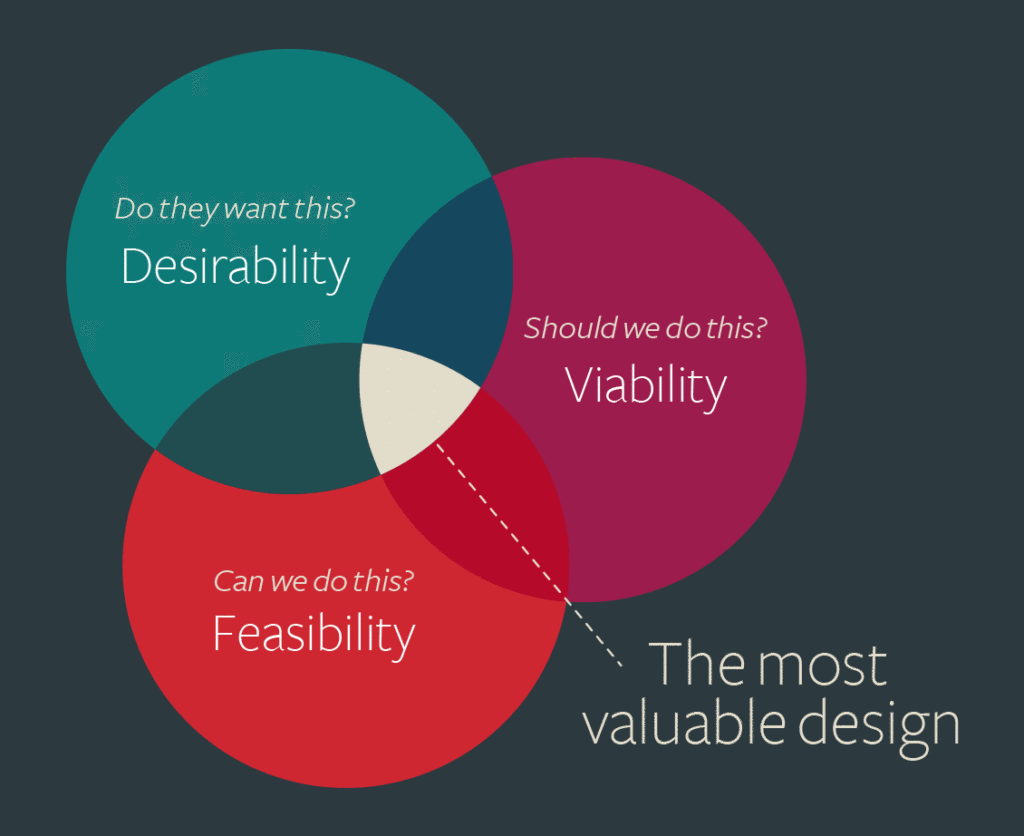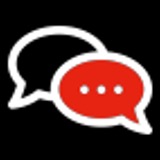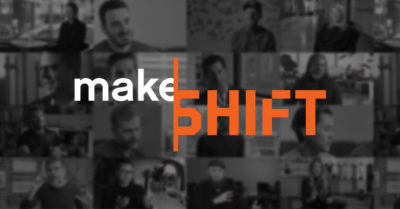Published on by Alex Cristache, Director of Design
At Crowd Favorite, our team approaches design the same way they approach life: success lies in balancing a given set of goals or requirements. As one of the leading articles on our site, it was time for a refresh. The value of balancing desirability, feasibility, and viability is still incredibly important to design, but it is time to review the topic in the age of digital transformation.
In almost all cases, “perfection” does not define success—rather, the best outcome lies at the intersection of desirability, feasibility, and viability.
In truth, the odds of every little bit of something being perfect are slim. Usually you have to give something up to get something. And sometimes when we get focused on our idea of a perfect outcome, we end up taking a very unbalanced approach and sacrificing other important aspects that our version of “perfection” failed to take into account.
Finding Balance Through Value-Centered Design
The current environment is leading to accelerated timelines, restricted budgets, and increased expectations. This is having a direct impact on digital transformation across every industry. While user-centered design has been the design mantra of the past few years, a newer concept that perfectly marries the business goals with the user needs has evolved, value-centered design.
Value-centered design focuses on attainable goals that add business value, while improving user experience; it is rooted in the core values and offerings of the business. Click To Tweet
A value-centered design approach can help identify and prioritize (feasibility) some of the users’ needs (desirability) when matched against the company’s goals (viability). As such, making it easier for merchants to set up and manage shops, and optimizing the customers’ checkout process would make excellent value-centered focus items. In addition to being balanced, this approach is powerful because it’s about designing with intention.
Let’s take Company A as an example, an eCommerce platform aiming at democratizing the eCommerce space by enabling merchants to sell their products through its system, while exposing their wares to a wider audience. From a business-driven perspective, Company A’s main goal would be to increase the number of sales completed through their system, in order to increase its commission-based profit. From a user-centered perspective, merchants desire easier access to the platform, easier inventory management, smaller fees, while customers desire easier access to relevant products, faster purchasing process, faster and cheaper deliveries. A value-centered approach would take into consideration the objectives of both the business goals, while producing end results that meet the user’s needs as well.
Much to our delight, IDEO (an organization we admire here at Crowd Favorite), has mapped this approach out very clearly. Here's a closer look at the concept:
“All of IDEO’s work is done in consideration of the capabilities of our clients and the needs of their customers. As we iterate toward a final solution, we assess and reassess our designs. Our goal is to deliver appropriate, actionable, and tangible strategies. The result: new, innovative avenues for growth that are grounded in business viability and market desirability.”
For IDEO, the most powerful use of this mental mode is realized when they’re innovating. But even when innovation isn’t the end goal, balancing desirability, feasibility, and viability is a great method for achieving the most valuable design solution in any situation.
It’s About Designing with Intention
In addition to being balanced, this approach is powerful because it’s about designing with intention. Our designers are always on the lookout for ways to improve the work we do and be more intentional in our methods. While we stay Zen about the normal ups and downs of any project, some obstacles can feel Godzilla-sized such as:
- Spending thousands of dollars on an app that nobody wanted in the first place
- Designing a solution that costs far more to implement than the client has in their budget
- Creating a content strategy that the client organization is unable to maintain in real life
Recently, we faced a challenge like this on a client project where the goal was to express to their audience why they do what they do. During our ideation and strategy phase, we used a lot of our resources for outlining the kind of experience that the audience would love. We did a good job of nailing the desirability side of the project with a concept that was sure to delight.
But we hadn’t discussed the scope and budget of the technology required to bring the idea to life, or the time and talent resource requirements the idea would impose on the client’s team. Because of this oversight, our solution ended up not being feasible, or even viable, for the client.
While our ideation phase of the project was rewarding, it wasn’t as efficient as it could have been if we had addressed these aspects in a more balanced and thorough way.
Aiming for the intersection of desirability, feasibility, and viability gives our process an invaluable advantage and balance. Considering all three facets helps us make sure we haven’t left out an important factor that would later become disturbingly obvious.
Asking the Right Questions Helps Keep Things on Course

When we balance desirability, feasibility, and viability, we increase the value of our design solutions—but how do we know whether these requirements have been met or not? Here are some questions that help keep things on course in the beginning of any project:
Desirability
Will this solution fill a need?
A great place to start is by checking to see if the project is adding value to the world.
Will it fit into people’s lives?
Understanding the people using our solution tells us how they live and in what way our solution supports or conflicts with their lifestyle and use cases.
Will it appeal to them?
While it shouldn’t be the only consideration, we also don’t want to neglect the appeal factor altogether.
Will they actually want it?
There’s no point going through the trouble (and resources) designing and executing on a project that nobody wants in the first place.
Feasibility
Is the technology needed to power the design solution available or within reach?
Sometimes the goal is to create a new technology, but sometimes we need to work with what we’ve got. Determine what your goal is on this front early on.
How long will this take?
Of course most of us would like to have what we want yesterday, and I’m not advocating for unreasonable deadlines. But when a reasonable client request is to have a project up and running in two months, yet our solution is projected to take six months to complete, it’s not a feasible solution. There’s no need to extend the timeline simply to accommodate our own ideals to the detriment of a client’s deadline.
Can the organization actually make it happen?
During the ideation phase of a project, we have to ask ourselves if the solution can be managed by the existing team responsible for keeping our solutions alive long after we’ve wrapped up our side of the work. A solution only works when the team can actually make it work in the long run.
Viability
Will the design solution align with the business goals?
By understanding what the business wants to accomplish, we can focus our energy in the right direction.
Does this solution honor the client’s budget?
We all have to work within budgets, and even if you have the best idea in the world, if it’s outside of the client’s budget then the solution isn’t viable.
What will the return on the investment look like?
I’m not just talking about money. It’s helpful to measure the effort needed to execute on a solution with the potential payoff in terms of desired outcomes—whether they’re monetary or some other quantifiable measure. If the investment far outweighs the benefits, it may be worth focusing on a different solution.
Changing the Current Culture of Design Innovation
Among the many challenges in the design industry, there are a few in particular that make this approach a valuable method. As designers, some of the situations that we continually work with are fast timeframes, increased competition, and mismatched or unclear expectations.
Dealing with Fast Timeframes
At the beginning of a project, it’s common to learn that a quick turnaround is necessary. In these scenarios, deep discussions early on (in the discovery phase if possible) about viability and feasibility provide focus. If there are technical limitations, they will inform the design solutions. The same goes for budget.
When working in a tight timeframe everyone on the team has a vested interest in working as efficiently as possible, so if there are things that just don’t make sense in this situation, tossing them overboard helps everything move along better.
Fierce Competition
There are more and more businesses competing for peoples’ attention. Using resources wisely to create things that people actually want is important. Designing a new widget for customers could give the client an edge, or it could be a tremendous waste of time and money that puts them further behind the competition.
This is why it’s important to ask “Do people really want this widget? Am I solving a problem, or just adding to the noise?” Do some digging to verify that the project is worth undertaking, this helps get projects started on the right foot and helps your clients stay competitive.
Clearing Up Expectations
When projects begin, we often find it difficult to ask the tough questions without feeling like a Debbie Downer. But it’s much more expensive to learn that something’s not desirable, feasible, or viable half way through the project.
Asking the hard questions about the intersection of all three facets up-front uncovers potential trouble spots early on so they can be avoided. By using this method as a tool, it becomes easier to dig into those tough questions and manage those emotions associated with perceived pushback.
That being said, keep an open mind about the client’s response. Perhaps for them being useful to a lot of people isn’t a high priority, maybe the delight factor is of utmost importance and worrying about viability just isn’t their top priority. There are hundreds of reasons to journey down project road, and if it’s at least discussed in the beginning our chances for defining and achieving the right version of success are much higher.
3 Practical Ways to Balance Desirability, Feasibility, and Viability
Apart from discussing the intersection of feasibility, desirability, and viability early on, there are some other things that can be done to help achieve this balance.
Communicate
Communicate. And communicate clearly. We joke at Crowd Favorite that our clients should be sick of hearing from us because we’re communicating with them so much. Frequent check-ins to make sure we’re on the right path and that we have the latest information are a way of life for us.
Do the Audience Research
The most obvious audience we design for is the end user or customer. By doing the research to understand them better, we’re able to zero in on solutions that are desirable to them. This is primarily covered by diving into the desirability factor.
Maybe it’s safe to say that if you are against research, you know in your heart that your pet product idea is a bad fantasy.
— Erika Hall (@mulegirl)
Don’t forget that a segment of your audience is actually the client. By interviewing the project stakeholders and the people who work with them (the people that will be keeping the project alive after it’s released into the world), we gain a deeper understanding of the internal project needs.
Our design direction will be directly informed by the skills, roles, resources, and current responsibilities of the organization we’re creating a solution for. It’s a very real parameter we need to work within and largely encompasses the feasibility and viability factors.
Be Thorough in Your Planning and Strategy Stages
When the stakes are high and competition is fierce, it’s tempting to move fast and skip the planning and strategy stages. Over the years it’s been our experience that when we neglect to plan and strategize carefully up front it cascades into lots of problems down the road.
Planning doesn’t happen just once. With consistent check-ins over the course of a project we can see if our progress is still aligning with the goals and make adjustments as needed.
Invest in the Future
The value of designing with this balanced approach is tremendous. People get something that makes their lives better. Resources are spent wisely and appropriately. Roadblocks and setbacks are avoided.
While attempting to achieve such a balance can sound daunting, design principles can help. As process-loving people, we're always looking for ways to distill a complex thought into bite-size pieces that we can incorporate into daily life. We use design principles often as tools for this, and our design principles for working toward a balance of desirability, feasibility, and viability are:
- Add value
- Make it work for people
- Know the business goals
- Make it actionable
- Stay flexible
One of our guiding principles at Crowd Favorite is to invest in the future, as we prefer decisions that make sense over a long period of time. When we strive for a balance of desirability, feasibility, and viability we’re doing just this: putting in the effort to create something that endures.
In a complex world with endless options, we're glad to have this technique to lean on to help point us in the right direction. It doesn’t ensure 100% success, and perfect compliance isn’t our goal. But it’s a good tool to have in our toolbox. If you feel like you could use some balance in your design approach, give it a try and see what value it adds for you and your team.
If you have a digital project in mind, now’s a great time to reach out!
*This article was originally published on Forty.co. Forty is now Crowd Favorite. Amy Lamp, former Forty Design Director.




